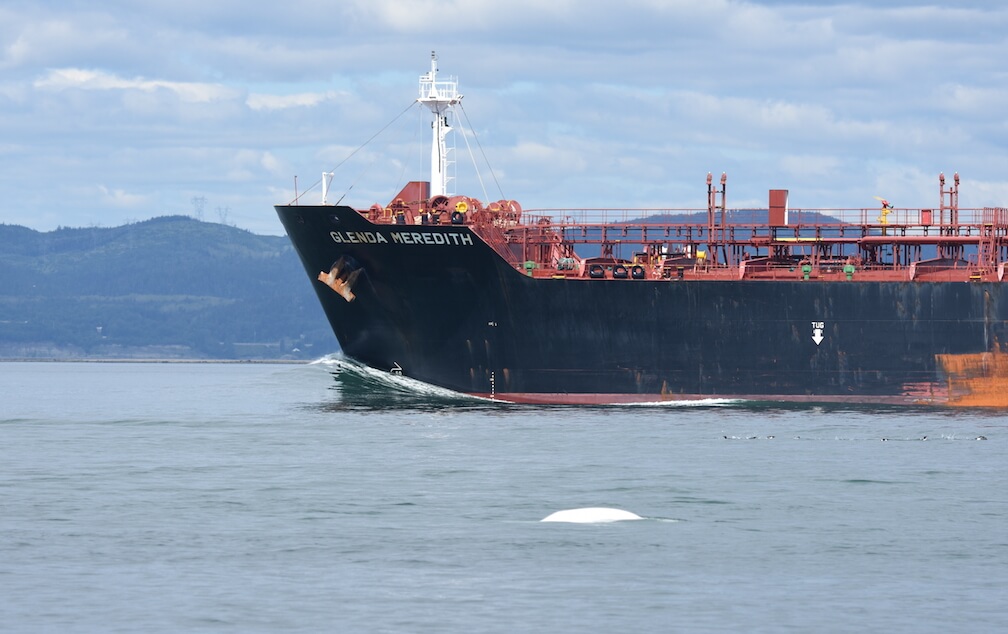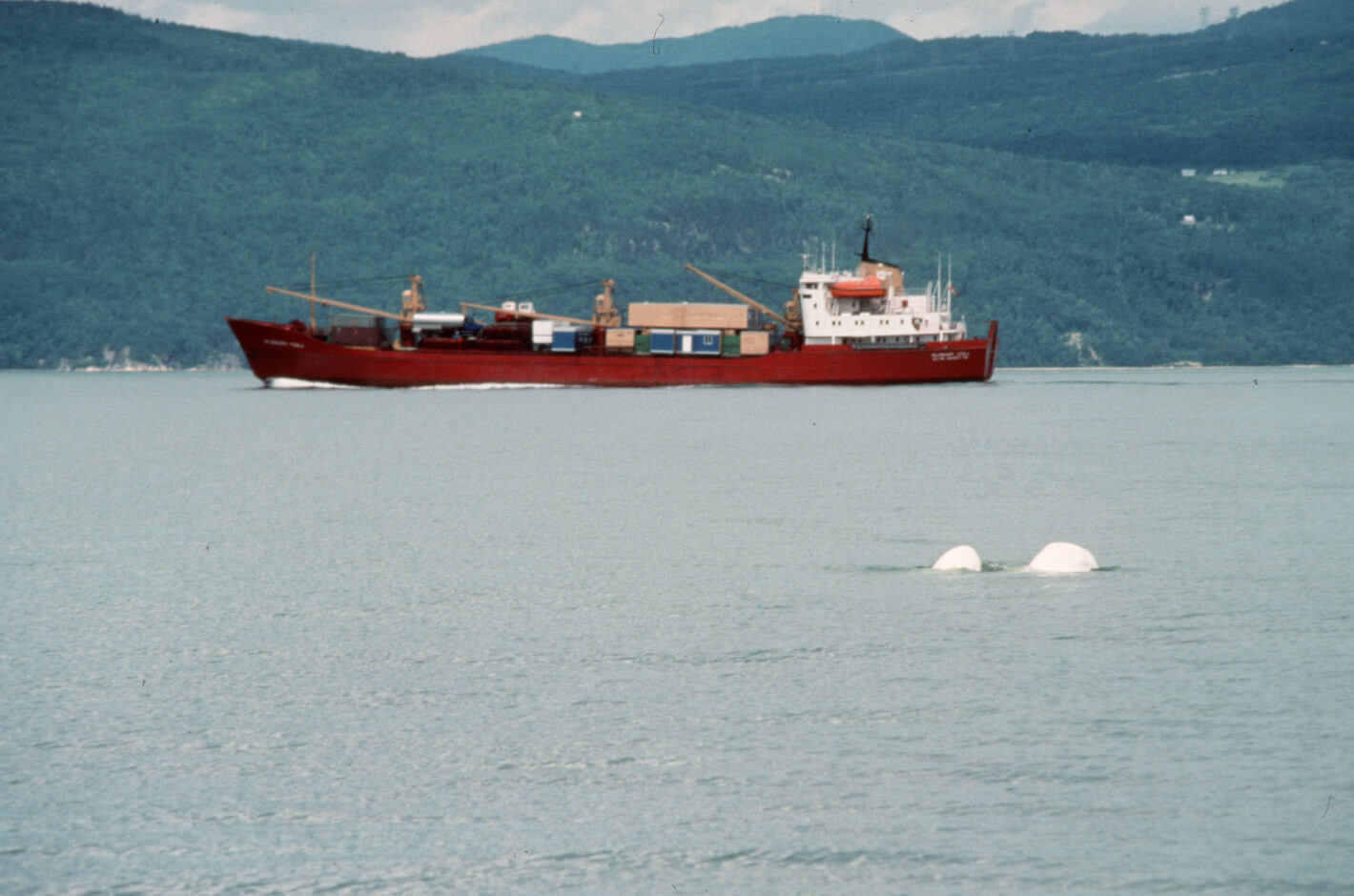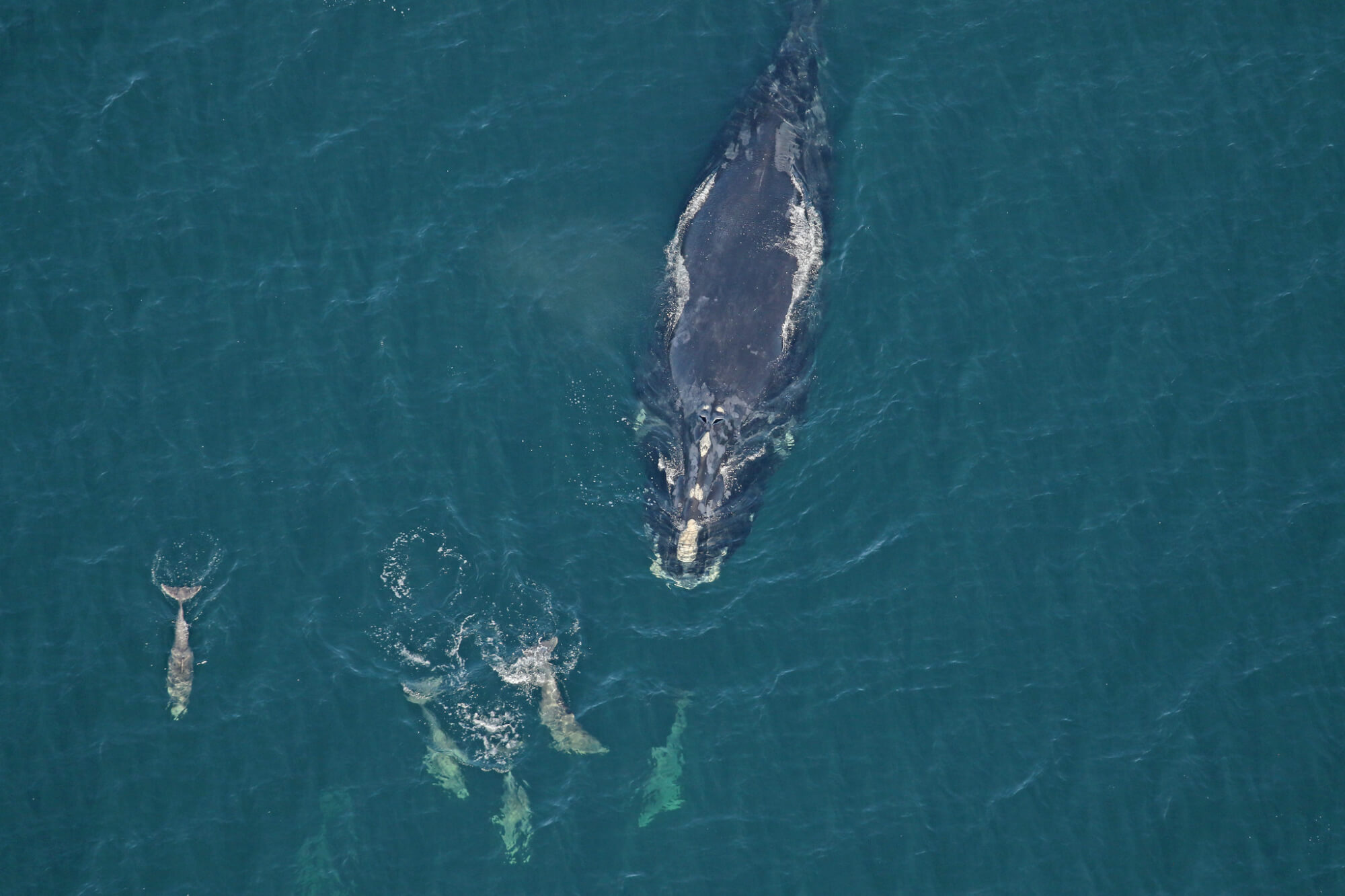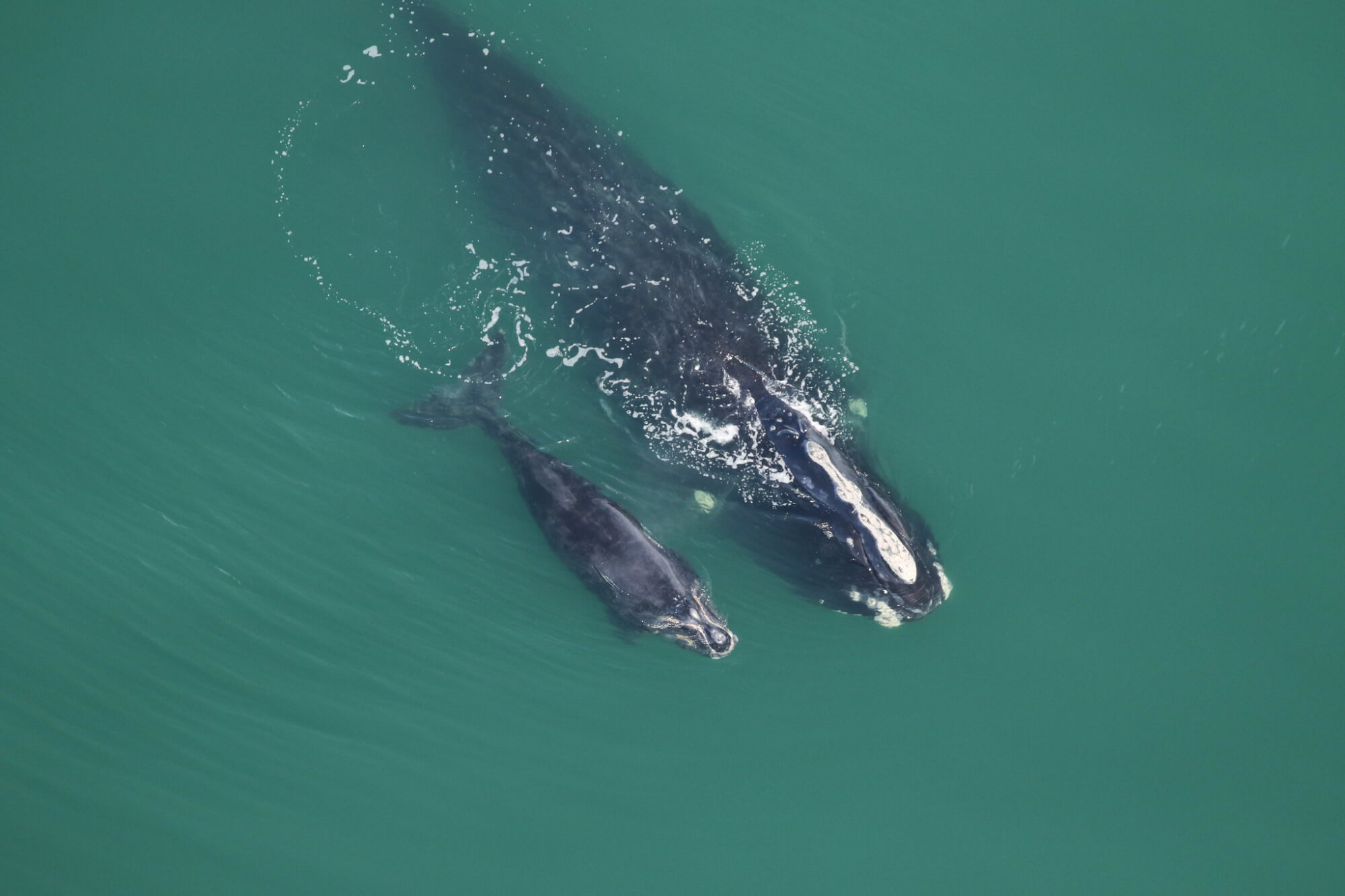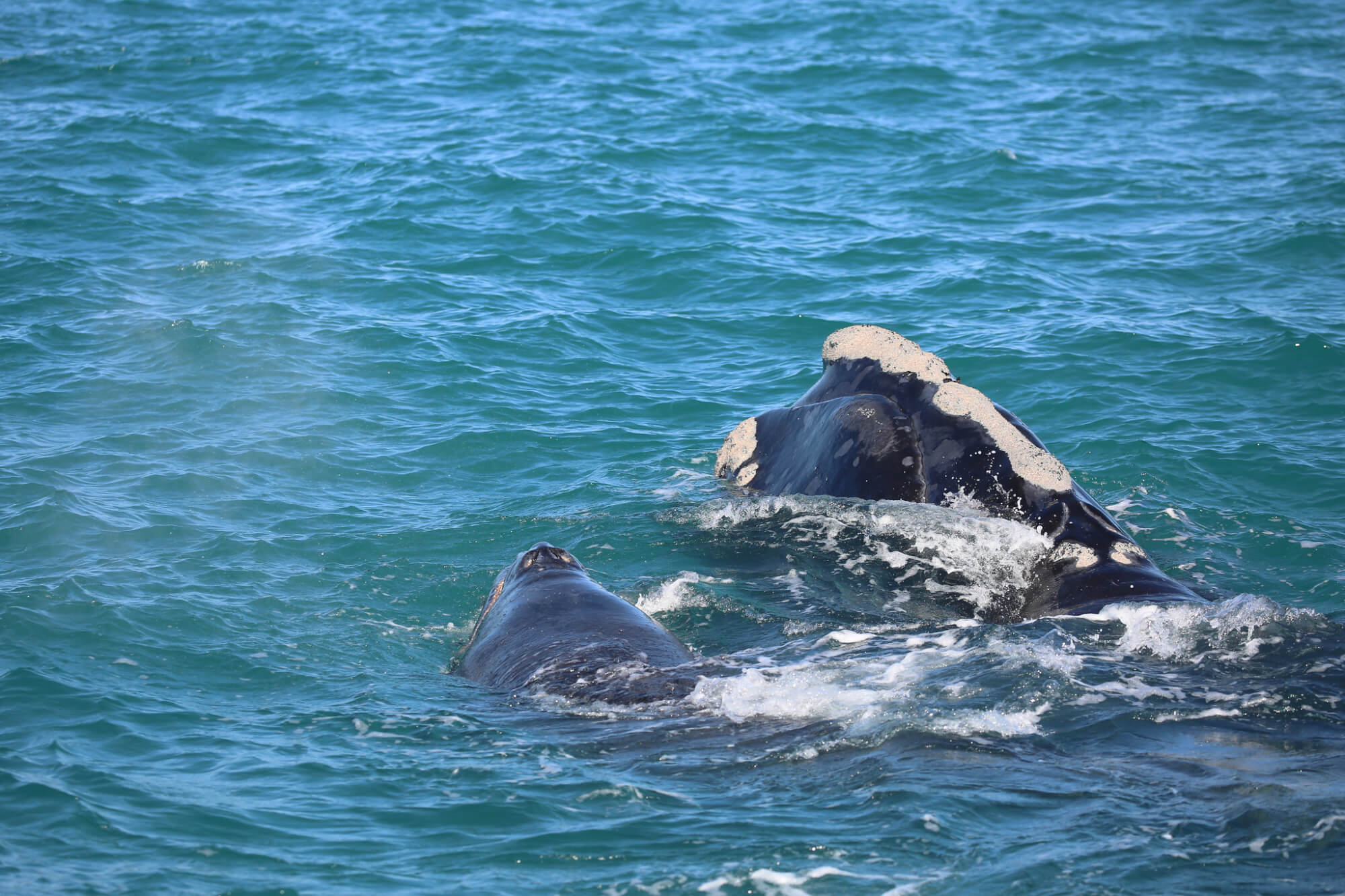Four industrial port development projects on the banks of the Saguenay River are in their final stages or have completed the government assessment process. At the same time, the wheels are in motion for other port development projects along the St. Lawrence, which could also increase maritime traffic in the Estuary. Once completed, shipping traffic stemming from these projects has the potential for major impacts on St. Lawrence belugas. In response, citizens and organizations are taking action. Whales Onlineis tracking these developments, from a “beluga’s” point of view. Discover potentially disruptive elements, reactions, and resources for staying informed.
St. Lawrence belugas are considered endangered under Canada’s Species at Risk Act. In order to provide a guideline for beluga protection measures, the population’s critical habitat – i.e. places essential for the species’ survival – has been identified. This habitat includes part of the St. Lawrence Estuary and sections of the Saguenay River.
Both toothed whales and belugas depend on sound for orientation. They use echolocation, meaning they emit and receive ultrasound to orient themselves and to identify obstacles and prey. Their sense of hearing is therefore critical for their survival.
Disturbance by watercraft and habitat degradation due to noise generated by shipping traffic are two of the main threats faced by St. Lawrence belugas. Development projects will each increase the number of vessels operating on the Saguenay. These ships then continue their course toward the Atlantic via the Estuary and the Gulf of St. Lawrence. Throughout the world, shipping traffic is on the rise, as is total tonnage, i.e. the weight of goods being transported by sea. The St. Lawrence is no exception.
Over the next few years, development projects at the ports of Québec City, Trois-Rivières, Contrecœur and Montréal will also contribute to the uptick in shipping traffic passing through critical St. Lawrence beluga habitat.
At the current time, the cumulative effect of noise on St. Lawrence belugas is not well understood. But the scientific community agrees: it does have an impact on marine mammals.Operating ships emit loud and prolonged sounds that have the potential to:
- Disturb the beluga in its behaviour
- Mask beluga communications or make them more difficult
- Mask echolocation clicks, affecting the animals’ ability to orient themselves or hunt effectively
- Temporarily or permanently impair the beluga’s hearing
- Cause chronic stress, which can harm the beluga’s health
It is in this context that Fisheries and Oceans Canada produced a “Science Response” document as part of the environmental assessment for marine terminal projects on the Saguenay. Researchers from Fisheries and Oceans Canada argue that “elevated risks [for belugas] cannot be ruled out given the current state of the declining population for which noise has been identified as a risk factor.” They later add, “Increasing anthropogenic pressure in this part of the habitat may further jeopardize the population’s recovery.”
Researchers indicate that the proposed development projects in the Saguenay will be incompatible with the objectives of the recovery plan adopted in 2012 and recently proposed measures to reduce the effect of stressors of human origin. You can read Whales Online’s complete summary of this document.
New research projects
What is the exposure level of belugas to noise in the Saguenay and St. Lawrence and what effect does it have on them? To answer these questions and many others, researchers are developing a simulator of marine mammal movements and shipping traffic as well as sound propagation in critical beluga habitat. Conducted by Université du Québec en Outaouais and GREMM in collaboration with Fisheries and Oceans Canada, the simulator will become a decision-making tool for use in evaluating various maritime development scenarios in the Saguenay and the St. Lawrence Estuary. The goal: to identify measures for reducing belugas’ cumulative exposure to noise. “Until we have access to the results, patience and caution are key to avoid significant harm to St. Lawrence belugas,” points out Robert Michaud, scientific director of the Group for Research and Education on Marine Mammals. “The Saguenay is still relatively quiet; it’s a sort of natural acoustic refuge. If all these projects were to launch before we had a chance to assess the importance and function of this acoustic sanctuary in cumulative exposure, we would risk losing an effective protection strategy.”

Preliminary results show that more than half of all St. Lawrence belugas and two-thirds of females frequent the Saguenay. The discovery is an important one: belugas’ exposure levels to boating and shipping noise predicted by their simulator – which is being developed to better assess the impact of noise and navigation and the best strategies to mitigate these impacts – are three times higher when consideration is given to the complex social characteristics of belugas and their distribution patterns. These results are raising concern amongst researchers, who recommend imposing a moratorium on the assessment of projects that could lead to a spike in maritime traffic in the Saguenay.
“Our results cast some doubt on the validity of the acoustic impact studies carried out to date for the beluga,” points out Clément Chion, director of UQO’s interdisciplinary socio-ecological simulation laboratory and director of the research program funded by the Government of Quebec. These studies did not take into account actual use of the site by belugas. They were based on the fact that less than 5% of the Saguenay population is found on average in the Saguenay at any given time. However, the studies failed to note that this 5% is not always made up of the same individuals.
For the moment, the Saguenay is a natural acoustic refuge. “We need to better understand how an increase in maritime traffic in the Saguenay will affect belugas, but above all, how to mitigate or compensate for the effects to ensure the belugas’ survival in the St. Lawrence,” warns GREMM’s scientific director Robert Michaud.
Clement Chion indicates that this moratorium is not permanent. “With the commitment of stakeholders in the public and private sectors, our simulator, which I have been working on for 15 years, will help reconcile boating and shipping with the presence of whales. But between now and the time the program is completed, we must be careful not to make hasty decisions that could have damaging and irreversible ecological effects.”
In the Estuary and Gulf, as part of Canada’s Oceans Protection Plan, another complementary simulation project is evaluating interactions between underwater noise and whales in the St. Lawrence. The results of this project should also facilitate informed decision-making with regard to development projects.
Two field projects are collecting acoustic data to better understand the behavioural and physiological responses of belugas when exposed to underwater noise and how this noise might be masking their communication or echolocation. Collected data will be used as input for the two simulators.
To study underwater noise exposure at an individual level, data archivers called D-tags are placed on the animals. In 2018, GREMM’s team, in collaboration with Véronique Lesage of Fisheries and Oceans Canada, managed to install 12, for a total of 53 hours of monitoring. The archiver records not only sounds emitted by the beluga, but also ambient sounds as well as data on water depth and temperature, speed, acceleration and orientation of the beluga, etc. The team also records a considerable amount of other data (distance and angle of the animal from the research vessel, number and types of other vessels relative to the research vessel, behaviour of the animal, etc.) while attempting to maintain eye contact with the beluga. Data will notably be used to document behavioural changes during and after noise exposure and the consequences thereof.
Additionally, Ocean Wise researcher Valeria Vergara is continuing her project, which combines drone-based video recording with underwater acoustic recording to study contact calls in belugas. Contact calls are believed to be used to maintain group cohesion or the bond between mother and calf. In newborns, these calls have the same frequencies as the sounds emitted by watercraft engines, which makes them all the more likely to be masked.
BlackRock Metals
BlackRock Metals is aiming to develop a mine near Chibougamau to extract vanadium, titanium and magnetite and process them in a plant that would be built at the existing wharf in Grande-Anse, near the city of Saguenay. The concentrate would then be exported by ship. In May 2019, BlackRock Metals received the green light from the Government of Quebec to commence construction of its processing plant in La Baie as well as the mine.
Number of ships expected: 20 to 25 per year
Expected commissioning: 2020
Arianne Phosphate
Last October, Minister of Environment and Climate Change Catherine McKenna, authorizedthe Saguenay Port Authority to continue its efforts to develop a marine terminal on the north shore of the Saguenay in Sainte-Rose-du-Nord. This authorization is contingent on conditions and mitigation measures to be applied throughout construction. The project is linked to the development of the Arianne Phosphate mine in Lac à Paul.
Number of ships expected: minimum scenario: 1 to 2 vessels a week, maximum scenario: 2 to 3 vessels a week, for a total of approx. 50-150 vessels per year
Expected commissioning: Unknown
Énergie Saguenay – GNL Québec
This project includes the construction of a pipeline to transport natural gas, mostly shale gas from Alberta, to a future liquefied natural gas (LNG) liquefaction plant in La Baie. LNG would then be exported by ship. The proposed pipeline route passes through wildlife habitats that are critical to endangered species such as the woodland caribou and wolverine.
Number of ships expected: 3 to 4 vessels per week or 6 to 8 under the maximum scenario, i.e. approx. 160-230 per year
Expected commissioning: 2025
Iron recycling plant – Grand River Ironsands
More to come
These various projects are raising fears among citizen groups as well as organizations dedicated to nature protection and promotion. However, it was really the Énergie Saguenay project that set fire to the powder keg.
On November 2, 2018, citizens and environmental protection organizations joined forces to form “Coalition Fjord” and pool their efforts to mobilize individuals concerned by the situation. Beyond belugas, it is the entire ecosystem that Coalition Fjord is aiming to protect.
In early January 2019, environmental groups, lawyers and citizens requested that the governments of Quebec and Canada conduct an environmental assessment of the project as a single whole, rather than evaluating the plant and the gas pipeline separately, arguing that the two projects are mutually dependent. The different groups also maintain that a separate assessment neglects to take greenhouse gases produced during natural gas extraction into consideration. On May 8, citizen and environmental groups even called on the Canadian Environmental Assessment Agency to consider the potential impacts of project-related shipping traffic. Since then, the CEAA has “undertaken a review of the scope of current environmental assessments,” reported Le Devoir on May 23. The public may submit comments on the summary of the impact assessment for the GNL Québec project through June 17.
On June 3, 2019, over 150 Quebec scientists signed and published an open letter (in French) in Le Devoir requesting the Quebec and Canadian governments not to support the GNL Québec project. The same day, GNL Québec replied with a counter-argument on its website (in French). On June 15, a demonstration is organized in Tadoussac to put pressure on the governments.
On September 10, 2019, the Group for Research and Education on Marine Mammals (GREMM) is publishing a video to answer the many questions that are being asked about industrial port projects being developed along the Saguenay. “I’m particularly concerned about belugas,” remarks from the outset GREMM scientific director and beluga specialist Robert Michaud. The video is in French, but subtitles are available by clicking on the cc button.
The belugas of the St. Lawrence represent an endangered population. Among the threats they face, noise pollution is at the top of the list. Belugas depend on sound to orient themselves, hunt, communicate and socialize. And in order to be able to make use of these sounds, they must be in a relatively quiet environment.
Throughout St. Lawrence beluga habitat, marine traffic is on the rise, as are noise levels and the duration of exposure to such noise. But some sectors remain relatively unaffected by merchant shipping. Such sectors include the Saguenay Fjord and the south shore of the Estuary (Cacouna / Rivière-du-Loup / Kamouraska area). They form “acoustic refuges”, which are relatively quiet places most of the time. “These shelters are believed to be of particular importance for beluga health,” explains Michaud. To validate this hypothesis, which is shared by a number of scientists, the GREMM team is collaborating with researchers from the Université du Québec en Outaouais, Fisheries and Oceans Canada and the Quebec Ministry of Forests, Wildlife and Parks. The results of their research should be able to guide how the St. Lawrence and the Saguenay are developed in an effort to reduce beluga noise exposure.
Until the results are available, Robert Michaud calls for patience and caution. “Losing these shelters means risking irreparable impact on this small, fragile population,” he worries.
Arianne Phosphate and marine terminal in Sainte-Rose-du-Nord
Canada:Marine Terminal Project on the North Shore of the Saguenay:Preliminary Environmental Assessment Report
Quebec:Commissioning and operation of apatite mine project in Lac-à-Paul, Saguenay–Lac-Saint-Jean Region(in French)
Énergie Saguenay – LNG and marine terminal in La Baie
Canada: Énergie Saguenay Project
Quebec: Forthcoming
Énergie Saguenay created a table to follow the process of the environmental assessments. You can consult it here.
BlackRock Metals and dockside plant in Grande-Anse
Canada: BlackRock mining project
Quebec: Planned processing plant for converting iron ore concentrate into pig iron and ferrovanadiumà Saguenay
Ressources
Reports and documents of interest
- (2020) Modélisation du trafic maritime et des déplacements des baleines dans l’estuaire du Saint-Laurent et le Saguenay pour informer le processus de réduction des impacts cumulatifs de la navigation sur les bélugas et les grands rorquals dans le contexte du déploiement de la Stratégie maritime du Québec: Rapport d’activités – An # 1 (2018-2019) Programme de recherche 2018-2023, Université du Québec en Outaouais et Groupe de recherche et d’éducation sur les mammifères marins.
- (2020) Programme de recherche sur la modélisation du trafic maritime et des déplacements des baleines dans l’estuaire du Saint-Laurent et le Saguenay en vue de la réduction des impacts du déploiement de la Stratégie maritime du Québec sur l’exposition des bélugas au bruit sous-marin de la navigation (2018-2023): Premières constatations et recommandations(synthèse), Université du Québec en Outaouais et Groupe de recherche et d’éducation sur les mammifères marins.
- (2019) Explanation of liquified natural gas (Clear Seas Centre for Responsible Marine Shipping)
- (2018) Underwater noises and marine mammals (Clear Seas – Centre pour le transport maritime responsable)
- (2018) Fisheries and Oceans Canada. Potential Effects of the Construction of Marine Terminals in the Saguenay Fjord on the St. Lawrence Beluga Whale and Its Habitat. DFO Can. Sci. Advis. Sec. Sci. Resp. 2018/025.
- (2018) Fisheries and Oceans Canada. Review of the Effectiveness of Recovery Measures for St. Lawrence Estuary Beluga.
- (2016) Group for Research and Education on Marine Mammals. Comments submitted to the Canadian Environmental Assessment Agency (CEAA).Marine terminal project on the north shore of the Saguenay – Port Saguenay (in French).
- (2012) Programme de rétablissement du béluga (Delphinapterus leucas), population de l’estuaire du Saint-Laurent au Canada, Série de Programmes de rétablissement de la Loi sur les espèces en péril, Pêches et Océans Canada, Ottawa, 93 + XI p.
On Whales Online
- GNL Québec promises fund to curb underwater noise pollution (11/02/2020)
- Une vidéo citoyenne contre le projet Énergie Saguenay (23/09/2019)
- «Perdre le refuge acoustique du Saguenay, c’est risquer des impacts irréparables pour les bélugas» (10/09/2019)
- Port Developments on the Saguenay: Fisheries and Oceans Canada Experts Sceptical (Whales Online, August 31, 2018)
The project in the medias
- Robert Michaud émet des réserves sur le fonds annoncé par GNL Québec (Style Libre, Ici Saguenay–Lac-Saint-Jean, 10/02/2020)
- GNL Québec injecte 5 M$ pour les bélugas (Le Quotidien, 10/02/2020)
- Financement offert par GNL: les universités doivent refuser (Le Quotidien, 06/02/2020)
- Le projet Énergie Saguenay pourrait-il être carboneutre? (Je vote pour la science, 05/02/2020)
- Alarm Bells Ring in a Whale Habitat Famed for its Silence (Hakai Magazine, 03/02/2020)
- Cent profs de l’UQAC s’opposent au projet de GNL Québec (Le Devoir, 01/02/2020)
- Énergie Saguenay: une carboneutralité aux coûts importants (Le Devoir, 15/10/2019)
- Lettre ouverte: Le projet GNL Québec, bon pour l’économie? (La Presse, 15/10/2019)
- How green is natural gas? The case for and against Quebec’s Énergie Saguenay project (CBC, 11/10/2019)
- Navigation durable sur le Saguenay: un comité scientifique est créé (Le Quotidien, 11/09/2019)
- Port de Saguenay: Bédard et Laberge défendent les projets (Le Quotidien, 10/09/2019)
- Croire en Grande-Anse (Le Quotidien, 10/09/2019)
- Le gazoduc devenu enjeu électoral (Le Quotidien, 06/09/2019)
- 40 000 signatures contre le projet GNL Québec (Le Quotidien, 05/09/2019)
- 40 000 signataires contre le projet GNL Québec (Neomédia.com, 05/09/2019)
- Énergie Saguenay: «impossible» d’éviter l’habitat du béluga, selon GNL Québec (Le Devoir, 05/09/2019)
- Impacts sur les bélugas: GNL Québec doit refaire ses devoirs (Le Quotidien, 04/09/2019)
- Être plus blanche qu’un béluga (Le Quotidien, 04/09/2019)
- Le problématique site d’Énergie Saguenay (Le Devoir, 04/09/2019)
- GNL Québec a mal évalué les impacts sur le béluga (Le Devoir, 03/09/2019)
- Lettre ouverte : Le projet GNL Québec doit être rejeté (Le Devoir, 02/06/2019)
- Énergie Saguenay: l’évaluation du fédéral pourrait inclure le transport maritime (Le Devoir, 23/05/2019)
- GNL Québec demande l’appui financier de l’État (Le Devoir, 14/05/2019)
- Projet gazier-Le Saguenay: l’économie ou l’environnement? (La Presse, 10/03/2019)
- La survie du béluga menacée par le projet Gazoduq au Saguenay (La Presse, 10/03/2019)
- Énergie Saguenay: l’évaluation fédérale exclut le transport maritime de sa définition du projet (Le Devoir, 19/02/2019)
- Projet Énergie Saguenay: à quel coût? (Je vote pour la science, 13/02/2019)
- Ottawa ignorera les GES émis en amont du projet Énergie Saguenay (Le Devoir, 07/02/2019)
- 17 dates de consultations publiques pour Gazoduq (Radio Énergie Abitibi, 28/01/2019)
- Sur la route du gazoduc (Ici Première, émission 24|60, 21/01/2019)
- Des espèces menacées sur la route d’un futur gazoduc (Le Devoir, 21/01/2019)
- L’opposition réclame une étude globale du projet de GNL Québec (Le Devoir, 16/01/2019)
- Le gouvernement dit non à une évaluation globale du projet de GNL Québec (Le Devoir, 15/01/2019)
- Milliards et biodiversité [éditorial] (Le Devoir, 14/01/2019)
- Avis défavorable aux projets de ports au Saguenay (Le Devoir, 11/01/2019)
- Ports sur le Saguenay : nuisibles aux bélugas, selon Pêches et Océans Canada (Radio-Canada, 11/01/2019)
- Rapport défavorable aux projets d’Énergie Saguenay et d’Arianne Phosphate : entrevue avec Robert Michaud (Ici Saguenay, émission Y’a des matins, 11/01/2019)
- Québec n’évaluera pas l’impact du gaz naturel transporté par Énergie Saguenay (Le Devoir, 21/12/2018)
- Un projet de gazoduc entre l’Abitibi et le Saguenay ne passe pas le test de l’opinion publique (Le Devoir, 19/12/2018)
- Bélugas : un projet de port minier qui inquiète (Gaïa Presse, 25/10/2018)
- Un port minier sera construit sur le Saguenay (Le Devoir, 24/10/2018)
- Des doutes sérieux sur le mégaprojet Arianne Phosphate (Le Devoir, 13/08/2018)
- Le trafic maritime en hausse dans le parc marin du Saguenay–Saint-Laurent (Le Devoir, 13/08/2018)
- Après le pétrole, le gaz de l’Ouest (Le Devoir, 09/05/2015)
Throughout St. Lawrence beluga habitat, marine traffic is on the rise, as are noise levels and the duration of exposure to such noise. But some sectors remain relatively unaffected by merchant shipping. Such sectors include the Saguenay Fjord and the south shore of the Estuary (Cacouna / Rivière-du-Loup / Kamouraska area). They form “acoustic refuges”, which are relatively quiet places most of the time. “These shelters are believed to be of particular importance for beluga health,” explains Michaud. To validate this hypothesis, which is shared by a number of scientists, the GREMM team is collaborating with researchers from the Université du Québec en Outaouais, Fisheries and Oceans Canada and the Quebec Ministry of Forests, Wildlife and Parks. The results of their research should be able to guide how the St. Lawrence and the Saguenay are developed in an effort to reduce beluga noise exposure.
Until the results are available, Robert Michaud calls for patience and caution. “Losing these shelters means risking irreparable impact on this small, fragile population,” he worries.


